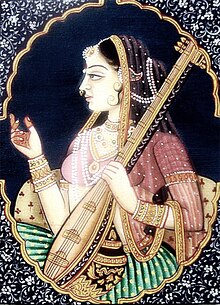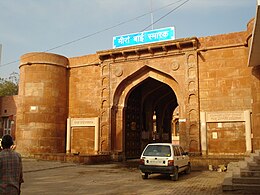Meera
From Wikipedia, the free encyclopedia
For other uses, see Meera (disambiguation).
| Meera | |
|---|---|
 Meerabai | |
| Born | c. 1498 Rajasthan, India |
| Died | c. 1547 Rajasthan, India |
| Philosophy | Sant tradition of the Vaishnava bhakti movement |
| An article related to Hinduism |
|---|
 |
 Hindu Mythology Portal |
Contents |
Biography
Meera, a Rajput princess was born in Kudki (Kurki), a little village near Merta City[1] which is presently in the Nagaur district of Rajasthan in northwest India. Her father, jai Singh aman, was a friend of the Rathore clan, the son of Rao Duda of Merta. Rao Duda was son of Rao Jodha of Mandore, founder of Mandsaur.As an infant Meera became deeply enamored of an iconic idol of Krishna owned by a visiting holy man; she was inconsolable until she possessed it and probably kept it all her life. (But some myths say that Meera saw a wedding procession of a bride-groom and asked her mother about her husband, then her mother took her in front of the family deity Lord Krishna. ) Then she was just five years old. She was highly influenced by her father as he was a sole worshipper of Krishna. But because she would not be able to keep the Lord happy the holy man took away the idol. Then she, her friend Lalita and her male cousin, Jaimal, went to the holy man or saint's house to get the idol back. When they went they saw that whatever the saint was offering to the Lord was not accepted. Then some ancient myths say that the idol started crying. Then next day the idol was given back to Meera and since then it remained with her. This made a bond between her and Lord and she was called "stone lover". She even organized a marriage with the idol. And she considered herself as spouse of Lord Krishna.
Meera’s marriage was arranged at an early age, traditionally to Prince Bhoj Raj, the eldest son of Rana Sanga of Chittor. She was not happy with her marriage as she considered herself already married to Krishna. Her new family did not approve of her piety and devotion when she refused to worship their family deity- Tulaja Bhawani (Durga).

The Meera Museum in Merta City
Meera's love to Krishna was at first a private thing but at some moment it overflowed into an ecstasy that led her to dance in the streets of the city. Her brother-in-law, the new ruler of Chittorgarh, was Vikramaditya, an ill-natured youth who strongly objected to Meera's fame, her mixing with commoners and carelessness of feminine modesty. There were several attempts to poison her.[2] Her sister-in-law Udabai is said to have spread defamatory gossip.
According to some myths Meera's brother-in-law Vikramaditya, who later became king of Chittor, after Bhojraj's death, tried to harm Meera in many ways, such as:
- The famous one is that he mixed poison in the prasadam or chandanamritam of Krishna and made her drink it. But by God's grace, Krishna changed it to Amrit.
- He pinned iron nails in Meera's bed, but, again by God's grace they turned into rose petals.
- He put a snake in a flower basket and told her that it was a gift from him to her Lord, but when she opened it actually became a gift- a garland.
At some time Meera declared herself a disciple of the guru Ravidas[3] ("guru miliyaa raidasjee") and left for the centre of Krishnaism, Vrindavan. She considered herself to be a reborn gopi, Lalita, mad with love for Krishna. Folklore informs us of a particular incident where she expressed her desire to engage in a discussion about spiritual matters with Rupa Goswami, a direct disciple of Chaitanya and one of the foremost saints of Vrindavan at that time who, being a renunciate celibate, refused to meet a woman. Meera replied that the only true man (purusha) in this universe is Lord Krishna.[4] She continued her pilgrimage, "danced from one village to another village, almost covering the whole north of India".[5] One story has her appearing in the company of Kabir in Kashi, once again causing affront to social mores. She seems to have spent her last years as a pilgrim in Dwarka, Gujarat. It is said that Mirabai disappeared into the Dwarkadhish Murti (Image of Lord Krishna) in front of a full audience of onlookers.
Poetry
Meera's songs are in a simple form called a ch' (verse), a term used for a small spiritual song, usually composed in simple rhythms with a repeating refrain, collected in her Padavali. The extant versions are in a Rajasthani and Braj, a dialect of Hindi spoken in and around Vrindavan (the childhood home of Krishna), sometimes mixed with Rajasthani.- That dark dweller in Braj
- Is my only refuge.
- O my companion, worldly comfort is an illusion,
- As soon you get it, it goes.
- I have chosen the indestructible for my refuge,
- Him whom the snake of death will not devour.
- My beloved dwells in my heart all day,
- I have actually seen that abode of joy.
- Meera's lord is Hari, the indestructible.
- My lord, I have taken refuge with you, your maidservant
English versions
Alston and Subramanian have published selections with English translation in India.[3][6] Schelling[7] and Landes-Levi[8] have offered anthologies in the USA. Snell[9] has presented parallel translations in his collection The Hindi Classical Tradition. Sethi has selected poems which Mira composed presumably after she came in contact with Saint Ravidas.[10] and Meera Pakeerah.Some bhajans of Meera have been rendered by Robert Bly in his Mirabai Versions (New York; Red Ozier Press, 1984). Bly has also collaborated with Jane Hirshfield on Mirabai: Ecstatic Poems.[11] Dr Prayag Narayan Misra has presented more than 20 devotional poems—available online in both Hindi and English languages.[12]
Popular culture
Composer John Harbison adapted Bly's translations for his Mirabai Songs. There is a documentary film A Few Things I Know About Her by Anjali Panjabi.[13] Two well-known films of her life have been made in India, Meera (1945), a Tamil language film starring M. S. Subbulakshmi, and Meera a 1979 Hindi film by Gulzar. TV series, Meera (2009–2010) was also based on her life.J. A. Joshi[14][15] has written a novel "Follow the Cowherd Boy"[16] published by Trafford Publishing[17] in 2006. Meera Bai's life has been interpreted as a musical story in Meera—The Lover..., a music album based on original compositions for some well known Meera bhajans, releasing 11 October 2009.[18]
Osho has given a commentary on Meera's bhajans.
Sagar Arts, the creator of mythological and historical serials such as Hatim Aladin, Chandragupta Maurya, Prithviraj Chauhan, Dwarkadheesh, Jai jai jai Bajrangbali, Mahima Shani Dev Ki, Ramayan etc., created a serial on July 27, 2009 – January 29, 2010. Younger Meera was played by Aashika Bhatia and elder Meera was played by Aditi Sajwan.


No comments:
Post a Comment